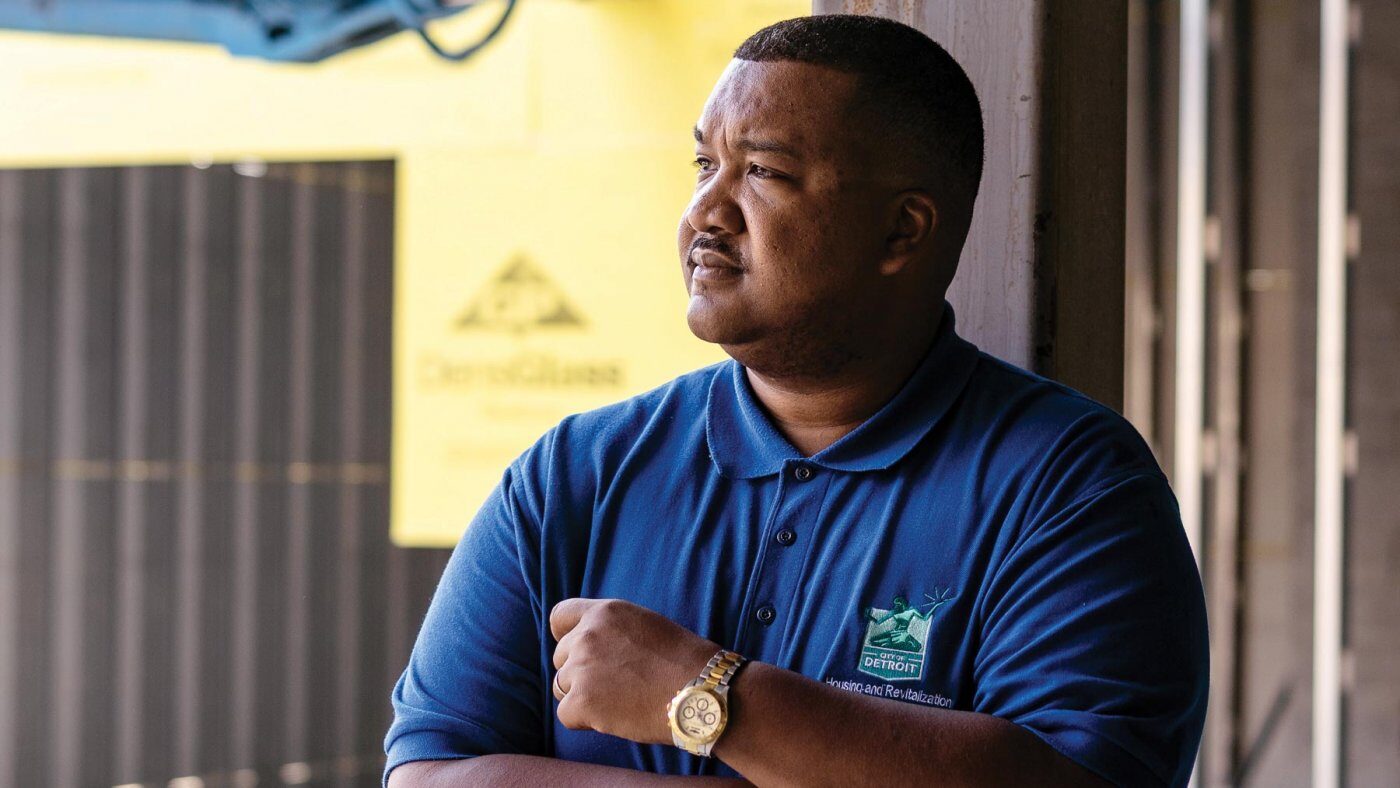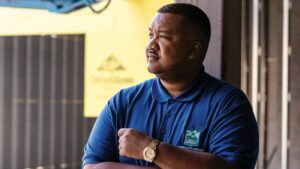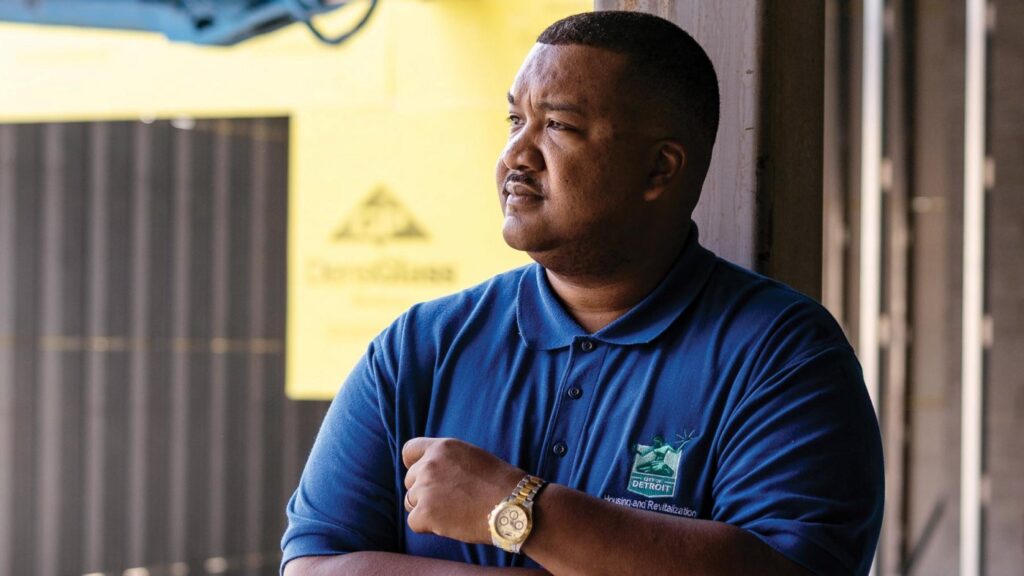Source: Portico Fall 2020

Jermaine Ruffin, M.U.P. ’17, is director of development–west region for the Detroit Department of Housing and Revitalization.

Jermaine Ruffin, M.U.P. ’17, is director of development–west region for the Detroit Department of Housing and Revitalization.
I have resisted talking about my personal and professional anxiety during these turbulent times because my internal voice always told me the timing wasn’t right. I convinced myself that I would be looked at as a pariah if I did not take the time to think out properly every syllable of what I wanted to communicate. I use my space and platform to discuss issues and opportunities within my profession, as well as highlight Black, Indigenous, and People of Color (BIPOC) who are working, fighting, and thriving in urban spaces. I am deeply committed to ensuring our voices are heard in a light that magnifies the issues, without romanticizing or “hero worshiping” the challenges and those staring them down every day. The effort of ensuring I met these self-imposed standards has often overwhelmed me to the point where I ended up doing nothing, because I simply didn’t want to fail.
Ironically, my anxiety used to drive me towards my goals; it also helped keep me alive and free of prison growing up in the PJs (projects). Being on high alert at all times, thinking through multiple ways to get home, avoiding house parties, and knowing every exit in every place I entered so I stayed alive was all too real for me. My anxiety forced me to better understand my neighborhood and city in an effort to make it to the next day. Understanding the impacts of poverty, crime, poor education, housing security and tenure, food deserts, hidden economies, and tactical placemaking were my Boy Scout badges.
My lived experience shaped me personally and my passions professionally. Yet I have long struggled with divorcing or healing from the trauma that informed those areas of my life. It took therapy, openly acknowledging the trauma, and this step that I am taking with you: sharing it. I now realize that my experience is similar to a lot of BIPOC built-environment professionals and activists. These people, my people, who approach the work with a level of passion informed by the trauma we experienced in our neighborhood. We take that same lived experience along with our fears, frustrations, anger, and passion to rectify these issues for future generations and set the standard for those BIPOCs who love the built environment.
This may not be why you entered into the urban planning space, but it is an all too real reason why many Black and Brown planners are in our field. We are mad as hell, not just at the current state of our profession, but of the world we have to continuously both fight against and fight within 24/7 of our existence. James Baldwin once said, “To be a Negro in this country and to be relatively conscious is to be in a state of rage almost, almost all of the time — and in one’s work.” This perfectly encapsulates the Black and Brown experience in urban planning, as well as the other built-environment professions. Most of us are extremely aware of the battle against our rage and distress at bad urban policy on our communities. Yet we believe in the greater opportunity to make a difference in challenged neighborhoods and cities across the world. We have to often take on the task of explaining to our colleagues who may not see or understand the harm those previous policies caused, while we inherently know or have experienced the harm directly or indirectly.
The consciousness of BIPOCs can become both enlightened and enraged in university classrooms. We must simultaneously learn the racist policies that powered our respective community’s social and economic devastation (often for the first time). Then we must reconcile this affirmed knowledge with our lived experience, which can be directly linked as an outcome of those policies. We learn this history in order to eventually wield that power in a righteous way, for our community’s collective progress. We must maintain the passion and promise that we can be the difference to preserve and increase BIPOC spaces and quality of life, where urban planning policies caused instability. As a profession, we must be as deliberate in dismantling systemic oppression as those who set the stage for the negative impact of policies that continuously show up in Black and Brown communities. The built environment academy and profession should acknowledge these negative impacts were the direct outcome of an era we must never repeat. Then make it clear that all the work moving forward, for all built environment professionals, will be consistent and purposeful to dismantle these systems.
This intentional work must clarify, once and for all, that Black Lives Matter in every space and in every way. The fatal experiences of Trayvon Martin, Michael Brown, Saundra Little, Breonna Taylor, Ahmaud Arbery, George Floyd, and so many others happened in the built environment. At the hands of law enforcement “protecting and serving” the people in the built environment. We need to be truthful as a profession of the roles of urban planners, architects, civil engineers, and other built-environment professionals of yesteryear (and some still today) in creating spaces, zoning ordinances, covenants, housing, and investment policies that provide fertile ground to perpetuate state violence against BIPOC neighborhoods and cities. This acknowledgment, along with intentional steps to increase representation of BIPOC in our respective professions, as well as developing adaptive tools for communities impacted by poor policy decisions, should be our remedy.
I sincerely believe the built-environment professions need BIPOCs to lead now more than ever.
The voices of Black and Brown planners and our allies will shape the future of this country’s neighborhoods and the world. I intend to be a part of this change, no matter how much my anxiety tells me the time isn’t right or you don’t have all of the “right words” to bring clarity yet. That same excuse is used by actors in urban spaces who are averse to new ideas or changing our profession to be more representative of the cities and neighborhoods we serve. We must speak and act in a way that ensures equity and dismantles systems that oppress Black and Brown people. I’d rather make mistakes on my way to support our greater community freedom than to sit idly by while our profession continues to hinder the progress of BIPOC neighborhoods and cities throughout the world. I have never forgotten that anytime, anywhere, or anyplace that the streets are planning, so we must as well.
Jermaine Ruffin, M.U.P. ’17, is director of development–west region for the Detroit Department of Housing and Revitalization. His essay originally appeared on Medium.com in July 2020.


